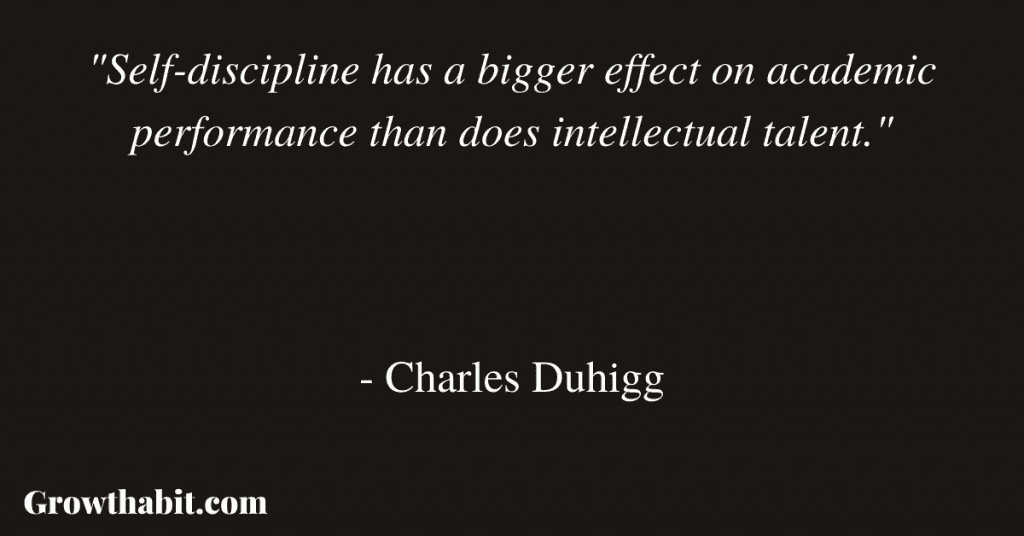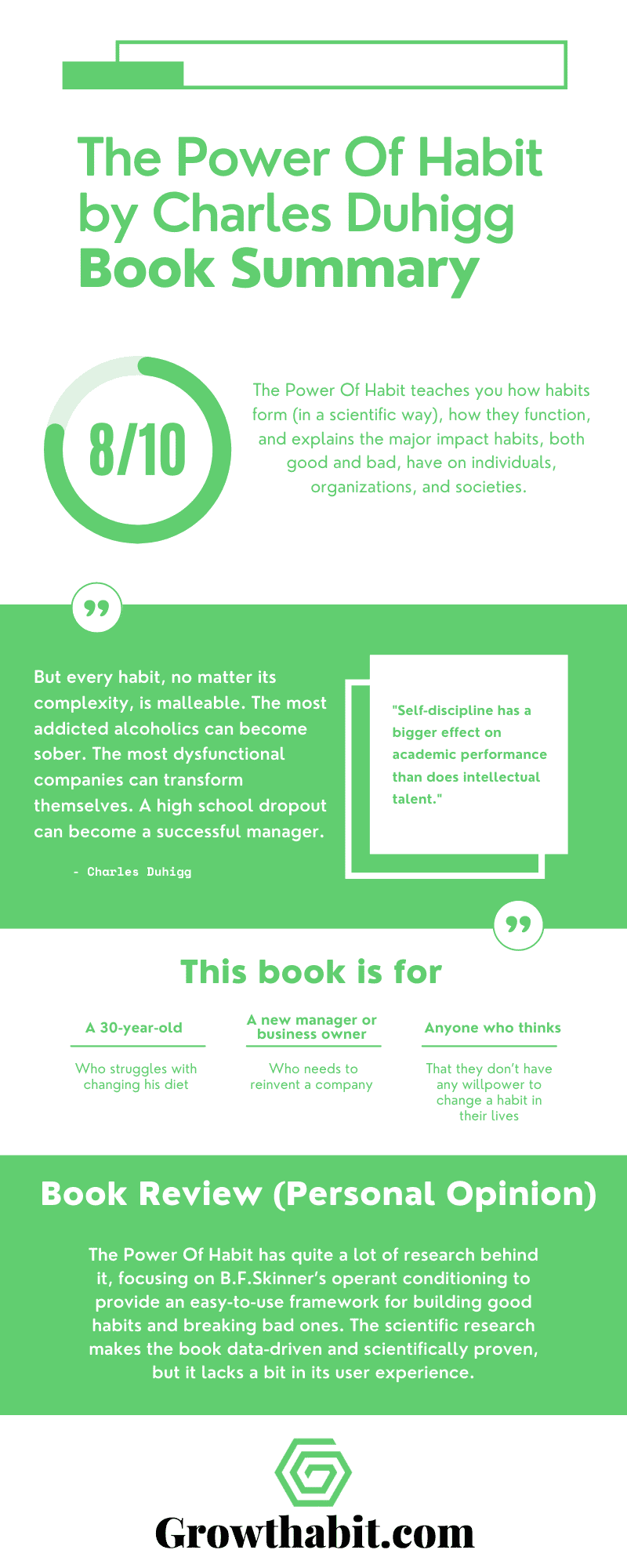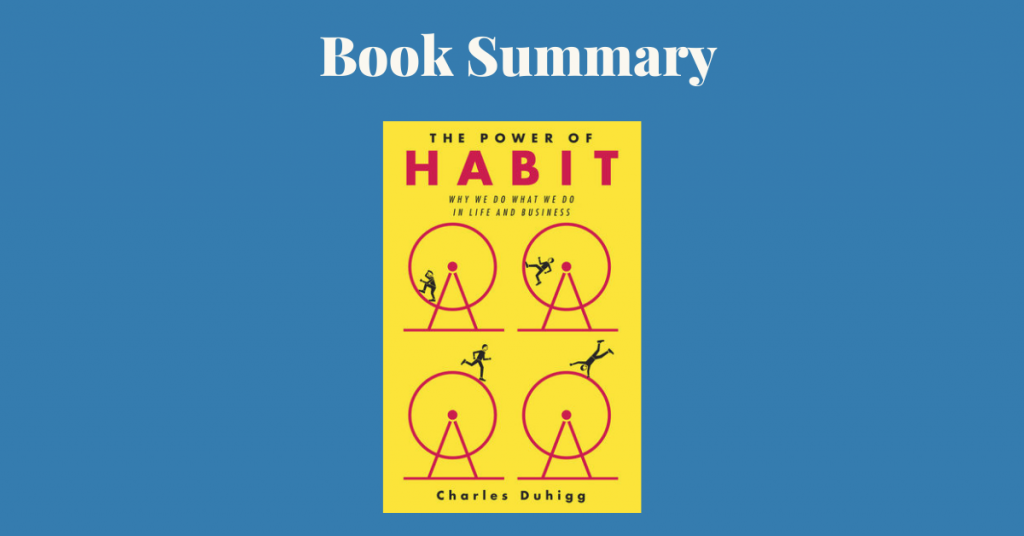Book Title: The Power Of Habit: Why We Do What We Do In Life And Business
Author: Charles Duhigg
Date of Reading: January-February 2017
Rating: 8/10
What Is The Book About As A Whole:
The Power Of Habit teaches you how habits form (in a scientific way), how they function, and explains the major impact habits, both good and bad, have on individuals, organizations, and societies.
What Is Being Said In Detail:
The Power Of Habit is divided into three parts: habits of individuals, habits of organizations, and habits of societies.
The most important points the author makes are:
- Habits form in a three-step loop: cue (the signal/trigger that comes internally or externally), routine (the behavior that you), reward (the negative or positive impact of doing the behavior that your brain remembers)
- Habits are the easiest to change not by changing the cue or reward, but by changing the routine.
- Keystone habits have the biggest impact. They are the habits that impact all other habits (think about nutrition or sleep, or in the case of organizations like Alcoa—safety at work)
- To succeed, build small habits because they lead to big habits and big wins (gaining momentum is important)
- Transforming your habits is always easier in a group (but it goes both ways— bad groups pull you down, good groups lift you up)
- Leaders use crises to change organizational habits. They know that culture eats strategy for breakfast, and that to create a sustainable change in your organization, you need to change what (and how) people do things every day (habits).
- Habits often change during major events (works for individuals, organizations, and societies as well).
- You can stack positive habits together to create habit loops and change your life for the better
Most Important Keywords, Sentences, Quotes:
By focusing on one pattern—what is known as a “keystone habit”—Lisa had taught herself how to reprogram the other routines in her life, as well.
“You’re helping us understand how a decision becomes an automatic behavior,” the doctor told her.
Most of the choices we make each day may feel like the products of well-considered decision-making, but they’re not. They’re habits.
And though each habit means relatively little on its own, over time, the meals we order, what we say to our kids each night, whether we save or spend, how often we exercise, and the way we organize our thoughts and work routines have enormous impacts on our health, productivity, financial security, and happiness.
When the major met with Kufa’s mayor, he made an odd request: Could they keep food vendors out of the plazas? Sure, the mayor said. A few weeks later, a small crowd gathered near the Masjid al-Kufa, or Great Mosque of Kufa.
Throughout the afternoon, it grew in size. Some people started chanting angry slogans. Iraqi police, sensing trouble, radioed the base and asked U.S. troops to stand by.
At dusk, the crowd started getting restless and hungry. People looked for the kebab sellers normally filling the plaza, but there were none to be found. The spectators left. The chanters became dispirited. By 8 P.M., everyone was gone.

At the time, no one wondered how a man who couldn’t draw a map of his home was able to find the bathroom without hesitation.
But that question, and others like it, would eventually lead to a trail of discoveries that has transformed our understanding of habits’ power.
It would help spark a scientific revolution that today involves hundreds of researchers who are learning, for the first time, to understand all the habits that influence our lives.
And within their brains, something unexpected occurred: As each rat learned how to navigate the maze, its mental activity decreased.
As the route became more and more automatic, each rat started thinking less and less… The basal ganglia, in other words, stored habits even while the rest of the brain went to sleep.
This process—in which the brain converts a sequence of actions into an automatic routine—is known as “chunking,” and it’s at the root of how habits form There are dozens—if not hundreds—of behavioral chunks that we rely on every day.
Some are simple: You automatically put toothpaste on your toothbrush before sticking it in your mouth. Some, such as getting dressed or making the kids’ lunch, are a little more complex.
Habits, scientists say, emerge because the brain is constantly looking for ways to save effort. Left to its own devices, the brain will try to make almost any routine into a habit, because habits allow our minds to ramp down more often.
This effort-saving instinct is a huge advantage. An efficient brain requires less room, which makes for a smaller head, which makes childbirth easier and therefore causes fewer infant and mother deaths.
An efficient brain also allows us to stop thinking constantly about basic behaviors, such as walking and choosing what to eat, so we can devote mental energy to inventing spears, irrigation systems, and, eventually, airplanes and video games.
This process within our brains is a three-step loop. First, there is a cue, a trigger that tells your brain to go into automatic mode and which habit to use.
Then there is the routine, which can be physical or mental or emotional. Finally, there is a reward, which helps your brain figure out if this particular loop is worth remembering for the future.
Every McDonald’s, for instance, looks the same—the company deliberately tries to standardize stores’ architecture and what employees say to customers, so everything is a consistent cue to trigger eating routines.
The foods at some chains are specifically engineered to deliver immediate rewards— the fries, for instance, are designed to begin disintegrating the moment they hit your tongue, in order to deliver a hit of salt and grease as fast as possible, causing your pleasure centers to light up and your brain to lock in the pattern. All the better for tightening the habit loop.
Claude Hopkins was best known for a series of rules he coined explaining how to create new habits among consumers.
These rules would transform industries and eventually became conventional wisdom among marketers, educational reformers, public health professionals, politicians, and CEOs.
Even today, Hopkins’s rules influence everything from how we buy cleaning supplies to the tools governments use for eradicating disease. They are fundamental to creating any new routine.
He created a craving. And that craving, it turns out, is what makes cues and rewards work. That craving is what powers the habit loop.
First, find a simple and obvious cue.
Second, clearly define the rewards.
This explains why habits are so powerful: They create neurological cravings. Most of the time, these cravings emerge so gradually that we’re not really aware they exist, so we’re often blind to their influence.
But as we associate cues with certain rewards, a subconscious craving emerges in our brains that starts the habit loop spinning.
But countless studies have shown that a cue and a reward, on their own, aren’t enough for a new habit to last.
Only when your brain starts expecting the reward— craving the endorphins or sense of accomplishment—will it become automatic to lace up your jogging shoes each morning.
The cue, in addition to triggering a routine, must also trigger a craving for the reward to come.
“Consumers need some kind of signal that a product is working,” Tracy Sinclair, who was a brand manager for Oral-B and Crest Kids Toothpaste, told me.
“We can make toothpaste taste like anything —blueberries, green tea—and as long as it has a cool tingle, people feel like their mouth is clean. The tingling doesn’t make the toothpaste work any better. It just convinces people it’s doing the job.”
“Foaming is a huge reward,” said Sinclair, the brand manager. “Shampoo doesn’t have to foam, but we add foaming chemicals because people expect it each time they wash their hair.
Same thing with laundry detergent. And toothpaste—now every company adds sodium laureth sulfate to make toothpaste foam more. There’s no cleaning benefit, but people feel better when there’s a bunch of suds around their mouth.
Once the customer starts expecting that foam, the habit starts growing.”
That’s the rule: If you use the same cue, and provide the same reward, you can shift the routine and change the habit. Almost any behavior can be transformed if the cue and reward stay the same.
What’s interesting about AA, however, is that the program doesn’t directly attack many of the psychiatric or biochemical issues that researchers say are often at the core of why alcoholics drink.
In fact, AA’s methods seem to sidestep scientific and medical findings altogether, as well as the types of intervention many psychiatrists say alcoholics really need. What AA provides instead is a method for attacking the habits that surround alcohol use.
AA, in essence, is a giant machine for changing habit loops. And though the habits associated with alcoholism are extreme, the lessons AA provides demonstrate how almost any habit—even the most obstinate—can be changed.
Belief was the ingredient that made a reworked habit loop into a permanent behavior.
When people join groups where change seems possible, the potential for that change to occur becomes more real.
“Change occurs among other people,” one of the psychologists involved in the study, Todd Heatherton, told me. “It seems real when we can see it in other people’s eyes.”
“If you want to understand how Alcoa is doing, you need to look at our workplace safety figures. If we bring our injury rates down, it won’t be because of cheerleading or the nonsense you sometimes hear from other CEOs.
It will be because the individuals at this company have agreed to become part of something important: They’ve devoted themselves to creating a habit of excellence.
Safety will be an indicator that we’re making progress in changing our habits across the entire institution. That’s how we should be judged.”
“Individuals have habits; groups have routines,” wrote the academic Geoffrey Hodgson, who spent a career examining organizational patterns. “Routines are the organizational analogue of habits.
“Another executive told me that one day, he stopped at a street excavation near his house because they didn’t have a trench box, and gave everyone a lecture on the importance of proper procedures.
It was the weekend, and he stopped his car, with his kids in the back, to lecture city workers about trench safety. That isn’t natural, but that’s kind of the point. We do this stuff without thinking about it now.”
Keystone habits offer what is known within academic literature as “small wins.” They help other habits to flourish by creating new structures, and they establish cultures where change becomes contagious.
“Once a small win has been accomplished, forces are set in motion that favor another small win.”
Small wins fuel transformative changes by leveraging tiny advantages into patterns that convince people that bigger achievements are within reach.
But this keystone habit—food journaling—created a structure that helped other habits to flourish. Six months into the study, people who kept daily food records had lost twice as much weight as everyone else.
Self-discipline has a bigger effect on academic performance than does intellectual talent.
Someone’s buying new towels, sheets, silverware, pans, and frozen dinners? They probably just bought a new house—or are getting a divorce.
A cart loaded up with bug spray, kids’ underwear, a flashlight, lots of batteries, Real Simple, and a bottle of Chardonnay? Summer camp is around the corner and Mom can hardly wait.
If you use your Target credit card to purchase a box of Popsicles once a week, usually around 6:30 p.m. on a weekday, and megasized trash bags every July and October, Target’s statisticians and computer programs will determine that you have kids at home, tend to stop for groceries on your way back from work, and have a lawn that needs mowing in the summer and trees that drop leaves in the fall.
It will look at your other shopping patterns and notice that you sometimes buy cereal, but never purchase milk—which means that you must be buying it somewhere else.
So Target will mail you coupons for 2 percent milk, as well as for chocolate sprinkles, school supplies, lawn furniture, rakes, and—since it’s likely you’ll want to relax after a long day at work—beer.
The company will guess what you habitually buy, and then try to convince you to get it at Target.
The firm has the capacity to personalize the ads and coupons it sends to every customer, even though you’ll probably never realize you’ve received a different flyer in the mail than your neighbors.
Concerned, the Department of Defense approached dozens of the nation’s leading sociologists, psychologists, and anthropologists—including Margaret Mead and Kurt Lewin, who would go on to become celebrity academics—and gave them an assignment: Figure out how to convince Americans to eat organ meats.
Get housewives to serve their husbands and children the protein-rich livers, hearts, kidneys, brains, stomachs, and intestines that were left behind after the rib eyes and roast beef went overseas.
A movement starts because of the social habits of friendship and the strong ties between close acquaintances.
It grows because of the habits of a community, and the weak ties that hold neighborhoods and clans together.
And it endures because a movement’s leaders give participants new habits that create a fresh sense of identity and a feeling of ownership.
“Instead of stopping the movement, the opposition’s tactics had only served to give it greater momentum, and to draw us closer together,” King wrote.
“They thought they were dealing with a group who could be cajoled or forced to do whatever the white man wanted them to do. They were not aware that they were dealing with Negroes who had been freed from fear.”
“Some thinkers,” Aristotle wrote in Nicomachean Ethics, “hold that it is by nature that people become good, others that it is by habit, and others that it is by instruction.”
For Aristotle, habits reigned supreme. The behaviors that occur unthinkingly are the evidence of our truest selves, he said.
So “just as a piece of land has to be prepared beforehand if it is to nourish the seed, so the mind of the pupil has to be prepared in its habits if it is to enjoy and dislike the right things.”
But every habit, no matter its complexity, is malleable. The most addicted alcoholics can become sober. The most dysfunctional companies can transform themselves. A high school dropout can become a successful manager.

Share this Image On Your Site
Book Review (Personal Opinion):
The Power Of Habit has quite a lot of research behind it, focusing on B.F.Skinner’s operant conditioning to provide an easy-to-use framework for building good habits and breaking bad ones.
The scientific research makes the book data-driven and scientifically proven, but it lacks a bit in its user experience.
Rating: 8/10
This Book Is For (Recommend):
- A 30-year-old who struggles with changing his diet
- A new manager or business owner who needs to reinvent a company
- Anyone who thinks that they don’t have any willpower to change a habit in their lives
If You Want To Learn More
Here’s Charles Duhigg holding a TEDx about habits.
Charles Duhigg TEDxTeachersCollege
How I’ve Implemented The Ideas From The Book
Growthabit is the result of my habit stacking. I started a habit of reading 20 pages a day and in three years, I read 115 books.
I would sit down at my reading place (cue), opened up the book I was reading, read at least 20 pages (routine), and afterward, fill my habit tracker with the number of pages read and it would color itself green if it was more than 20 pages (reward).
So Growthabit formed because I wanted to share the way I formed a successful reading (and later on, writing) habit.
One Small Actionable Step You Can Do
Start one new habit and track it every single day. And what a coincidence, you can use my free habit tracker for that! 😀
